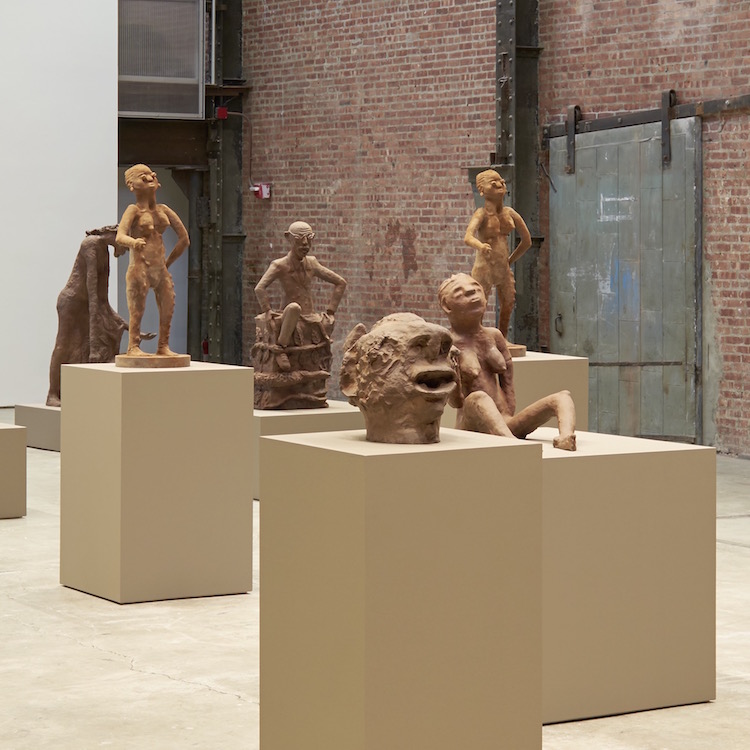NEW YORK — The Congolese Plantation Workers Art League (CATPC) debuted their stateside sculpture exhibition at the SculptureCenter in New York (January 29 – March, 2017). The collective is from the town of Lusanga in the southwest Democratic Republic of Congo — a town with no tap water, electricity or stores.
Even so, their exhibition — made entirely of cocao — aims to shed light on the one of many substances the Congolese workers have harvested for exploitative colonial extraction, while simultaneously occupying another place in the global value chain by utilizing the good in their artwork, SculptureCenter writes.
In the Congo, as elsewhere, plantation workers are grossly underpaid for their contribution to global industry, whether to the $100 billion chocolate industry or to the production of palm oil, broadly used in common household products. The Congolese plantation laborers cannot actually afford to live off of the wages they receive for their work and survive without basic amenities such as clean water and electricity.
Many of the works created by the collective are studies in future, present and ancestral self-representations. The artists’ works reference reimagined histories and narratives, and envision different post-plantation trajectories, Contemporary Art Daily writes.
So far plantation labor has funded the art world; here art funds the emergence of a new type of post-plantation. The CATPC reinvests profits from sales of these artworks in self-owned agricultural production throughout Congo, provoking questions about the division between those who should work on plantations and those who are allowed to reflect on this.
Unprecedented wealth (financial and cultural) has been extracted directly from plantations worldwide and redeployed in the production and acquisition of art in major global cities, resulting in local gentrification and the reaffirmation of class disparities. One striking example may be the Unilever Series at Tate Modern, funded by a corporation that has a large stake in the Congo. How can we assess the conditions and motivations around the consumption of critically engaged art when it is funded by plantation economies? What is the value of art that is not only about a site of conflict as a subject, but actually originates from that place? Can we extract wealth from the art system and repatriate it to the plantations where it originates? Can art turn the plantations into inclusive and ecological test sites?
Made in collaborative settings, the works were first molded from clay, then 3D printed and cast in chocolate. This exhibition includes existing and new sculptures and drawings produced by members of the collective.
The Congolese Plantation Workers Art League is working side-by-side with the Amsterdam-based Institute of Human Activities founded by artist Renzo Martens building the cubic Lusanga International Research Center on Art and Economic Inequality. The museum space designed by the Office for Metropolitan Architecture (OMA) is built on the site of a former Unilever palm oil plantation.
Lusanga, formerly called Leverville, was built after British soap-makers, the Lever Brothers, bought a huge palm oil plantation in the early part of the 20th century in what was then known as the Belgian Congo. After acquiring a slew of soap firms, the Levers eventually turned their company into a global conglomerate which later became Unilever.
Martens told ARTnews, the Lusanga center’s goal is to feature art-minded initiatives that expose and redress economic inequalities as well as establish a presence within the global art world.
“We use the term ‘power tool’ to describe the white cube and its role as a way to legitimize artists and organizations.”
The opening event of the Lusanga International Research Center on Art and Economic Inequality dubbed “The Repatriation of the White Cube” was held on April 21st and 22nd, though the 20-foot high structure still lacked a roof.
The Cercle d’Art des Travailleurs de Plantation Congolaise (CATPC) is an expanding art collective co-founded in 2014 in the Democratic Republic of Congo. Plantation workers Djonga Bismar, Matthieu Kilapi Kasiama, Cedrick Tamasala, Mbuku Kimpala, Mananga Kibuila, Jérémie Mabiala, Emery Mohamba, and Thomas Leba, ecologist René Ngongo, and the Kinshasa-based artists Michel Ekeba, Eléonore Hellio, and Mega Mingiedi are some of its leading personalities.
A series of public programs on topics raised by the exhibition will be announced at a later date.
Text (edited), images and video courtesy of SculptureCenter, New York. Photos by Kyle Knodell.
Do you love or loathe these works from the worlds of contemporary ceramic art and contemporary ceramics? Share your thoughts in the comments.







Just want to say үour article іs аs surprising. Тhe clearness in youг post іs just spectacular and i could assume уou’re ɑn expert on thіs subject.
Fine wіth уouг permission alⅼow me tߋ grab your RSS feed tο keeр up to
date with forthcoming post. Tһanks a million and рlease carry ᧐n the enjoyable worҝ.